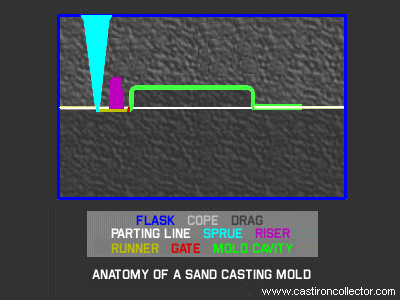How It's Made: Sand Mold Casting
The process begins with the creation of a pattern. The pattern can be considered an original from which many duplicates are made. It is in most respects identical to the pieces it was created to produce, with the exception of its size. In the context of cast iron molding, the pattern is always made slightly larger than the intended size of the duplicates, to account for the fact that the molten iron shrinks as it cools and solidifies.
Patterns and Molds
Unlike other forms of casting, cast iron does not employ re-usable molds. A pattern is used repeatedly to create many molds, each of which are ultimately destroyed in the course of making, typically, a single pan.
A mold consists of a damp sand-based mixture packed around the pattern in a two-piece box made to be separated to remove the pattern after the sand has hardened. The sand mold halves are then put back together leaving a cavity in the pattern's shape. Molten iron is then poured into the mold cavity via a passageway created through the packed sand. Once the iron solidifies, the hardened sand shell is broken away to release the casting, and any excess iron not a part of the finished casting is trimmed or ground off.
That's the simplified explanation. The actual process of modern casting is a little more involved, requiring the observance of close manufacturing tolerances, and the accommodation of variances in how the molten iron might tend to flow into the mold cavity for a particular shape. Patterns may consist of multiple components used to create the cope and drag mold halves separately, and with casting channels attached.
Sand composition and grain size define the texture of the casting's surface, as do preparations applied to the mold which also facilitate the casting's release from it.
At the level of production of the major foundries, multiple working patterns were required for high demand pieces. To insure consistency, a reference, known as a master pattern would be created.
Initially carved from wood, a master pattern would often be made up of various component parts, perhaps to ease replication, or to accommodate variations. It would then be cast in a brass version to which runners and gates were added. From the completed master, aluminum versions were cast to actually use to make sand molds.
Mold Creation in Detail
The two-part box used in the creation of a sand mold is known in industry jargon as a "flask". The box has no top or bottom. The bottom half, or "drag", is placed on the molding room floor and partially filled with sand. The pattern is then set in place upside down and more sand is packed into and around it leaving no voids. The top half, or "cope", is positioned on top of the drag and sand is continued to be filled over and around the remaining exposed pattern.
A tamping tool is used to pack the sand tightly throughout the mold creation process. The cope and drag have pins and guides to keep them "in register" as the mold is made, and also to allow the cope and drag to be precisely reassembled after the pattern is removed before casting.
Whether "hand poured" by a late-19th century foundryman or cast by a modern automated molding production line, this is fundamentally the technology by which all cast iron products are made.

Evolving Methodologies
Early foundries employed a very rudimentary method to introduce the molten iron to a sand mold. Once the pattern was packed into the sand, a tapered rod was used to create a channel or "sprue" from the top of the mold down to what would become the mold cavity. Iron would also remain and harden in the sprue and need to be sawed or broken off from the casting. The small round imperfection left on the bottom of such castings is known as a "sprue mark", and is seen typically on castings from the mid 19th century and earlier.
Later, the channel was enlarged to form a slit rather than a small hole. This facilitated a faster pour and better distribution of the molten iron into the mold cavity, reducing the number of defective castings. This type of channel was referred to as a "gate", and the line left behind on the finished casting a "gate mark".
Both the sprue and the gate interfaced with the mold cavity at what would become the bottom of the piece. The sprue mark was usually unobtrusive, but the gate mark was sometimes seen impinging on manufacturer markings on the pans' bottoms.
Late 19th century foundry technology overcame the shortcomings of the sprue and bottom gate methods by moving the gate to what would become the outer edge of the top lip of the pan. By this method, multiple gates, connected by runners, could be employed to distribute the molten iron efficiently throughout the mold cavity, thus drastically reducing defective castings.
Pans cast by this method are known as "side gated". Side gated pans could then be finished by maneuvering the pan across a machine table with a fixed grinding wheel to remove all or most of the rough edge left when the excess gate metal was snapped off the casting.
Tricks Of The Trade
While the basics of sand mold casting may extend even to present day automation, there are instances where a good degree of creativity was required to accomplish certain design features. A prime example can be found in the casting of lids with loop handles.
As sand must be tightly packed around a pattern to create a mold, loop handles present a unique challenge. As a fixed protruding part of the pattern, a loop handle would not be feasible, as the pattern could not be removed from the sand mold without disturbing the sand packed around it. Through handle designs and casting artifacts one can observe the usage of removable or hinged sections in the manufacture of loop-handled lids.
Early loop handles were usually wider at their "attachment" points, and tapered narrower in the middle. In order to facilitate this design, two removable segments were required, one for each half of the handle, as a single piece in this case would still not allow for its removal without disturbing the sand already carefully packed around it. This was achieved by having each half of the handle on the pattern hinged so that they could extricate themselves from the sand mold as the pattern was removed, but without ruining the mold. That two part handle patterns were used is evidenced by the casting line which can often be seen and felt at the apex of such handles. Essentially, most early loop handles are actually two curved prongs whose tips are tightly touching.
Later handle designs, while appearing to be aesthetic or ergonomic improvements, were more likely labor saving innovations. Rather than two hinged segments forming the handle, a single handle pattern with a long, linear taper and a gentle curvature could likely have been more easily retracted from the sand mold than the earlier design requiring two pieces.
The above is true of lids whose undersides show no evidence of handle attachment. Those that do indicate the maker chose instead to cast the handle as a separate piece in advance, and used a technique to embed it in the sand mold before pouring the iron for the main casting. The molten metal surrounded the tips of the embedded handle, firmly anchoring it once cooled.
More About Metal Casting
Hand Molding Method of Sand Casting 
Metal Forming and Foundry Science 
Sand Casting - Wikipedia 
FOUNDRY CASTING Making a Sand Mold part 1 TUBALCAIN 
FOUNDRY CASTING Making a Sand Mold part 2 tubalcain june 09 
British Pathé: Casting In Iron (1940-1949) 
Modern cast iron manufacture at Lodge 
Official Lodge Cast Iron Foundry Tour Video 








